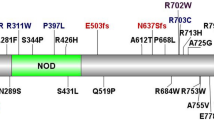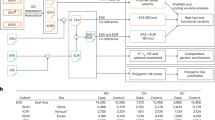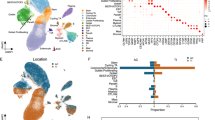Abstract
Linkage of IBD to the pericentromeric region of chromosome 16 has been widely confirmed by analyses of multiple populations. The NOD2 gene is located in the peak region of linkage on chromosome 16 and thought to be involved in the activation of nuclear factor (NF) κB in response to bacterial components. Mutations in the NOD2 gene are found to be strongly associated with susceptibility to Crohn's disease (CD). A total of 65 Irish CD families were genotyped to determine if NOD2 mutations conferred susceptibility to CD and the prevalence of these mutations in sporadic and familial forms of the disease. The Irish population is relatively homogenous and thus may provide advantages in genetic studies of complex diseases. We confirmed the IBD1 locus as a susceptibility locus for IBD within the Irish population by linkage analysis followed by linkage disequilibrium studies. No significant evidence of linkage was observed to the previously identified regions on chromosomes 1, 12 and 14. In all, 131 CD affected families were then genotyped for seven of the previously published NOD2 single-nucleotide polymorphisms (SNPs). Allelic transmission distortion was investigated using the pedigree disequilibrium test (PDT). SNP13 (3020insC) was found to be associated with CD (P=0.0186). Patients who possessed a rare allele of SNP8, 12 or 13 presented earlier when compared to patients without rare variants (mean age, 20.1 vs 24 years, P=0.011) and the rare allele of SNP13 was observed to be predominantly linked to ileal disease (P=0.02). This report confirms the importance of NOD2 as a susceptibility gene for CD within the Irish population.
Similar content being viewed by others
Log in or create a free account to read this content
Gain free access to this article, as well as selected content from this journal and more on nature.com
or
References
Podolsky DK: Inflammatory bowel disease (1). N Engl J Med 1991; 325: 928–937.
Tysk C, Lindberg E, Jarnerot G, Floderus-Myrhed B: Ulcerative colitis and Crohn's disease in an unselected population of monozygotic and dizygotic twins. A study of heritability and the influence of smoking. Gut 1988; 29: 990–996.
Satsangi J, Parkes M, Louis E et al: Two stage genome-wide search in inflammatory bowel disease provides evidence for suscepti-bility loci on chromosomes 3, 7 and 12. Nat Genet 1996; 14: 199–202.
Hugot JP, Laurent-Puig P, Gower-Rousseau C et al: Mapping of a susceptibility locus for Crohn's disease on chromosome 16. Nature 1996; 379: 821–823.
Cavanaugh J: International collaboration provides convincing linkage replication in complex disease through analysis of a large pooled data set: Crohn's disease and chromosome 16. Am J Hum Genet 2001; 68: 1165–1171.
Ogura Y, Bonen DK, Inohara N et al: A frameshift mutation in NOD2 associated with susceptibility to Crohn's disease. Nature 2001; 411: 603–606.
Cho JH, Nicolae DL, Gold LH et al: Identification of novel susceptibility loci for inflammatory bowel disease on chromosomes 1p, 3q, and 4q: evidence for epistasis between 1p and IBD1. Proc Natl Acad Sci USA 1998; 95: 7502–7507.
Cho JH, Nicolae DL, Ramos R et al: Linkage and linkage disequilibrium in chromosome band 1p36 in American Chaldeans with inflammatory bowel disease. Hum Mol Genet 2000; 9: 1425–1432.
Hampe J, Schreiber S, Shaw SH et al: A genomewide analysis provides evidence for novel linkages in inflammatory bowel disease in a large European cohort. Am J Hum Genet 1999; 64: 808–816.
Rioux JD, Silverberg MS, Daly MJ et al: Genomewide search in canadian families with inflammatory bowel disease reveals two novel susceptibility loci. Am J Hum Genet 2000; 66: 1863–1870.
Vermeire S, Satsangi J, Peeters M et al: Evidence for inflammatory bowel disease of a susceptibility locus on the X chromosome. Gastroenterology 2001; 120: 834–840.
Ma Y, Ohmen JD, Li Z et al: A genome-wide search identifies potential new susceptibility loci for Crohn's disease. Inflamm Bowel Dis 1999; 5: 271–278.
Duerr RH, Barmada MM, Zhang L, Pfutzer R, Weeks DE: High-density genome scan in Crohn's disease shows confirmed linkage to chromosome 14q11–12. Am J Hum Genet 2000; 66: 1857–1862.
Dib C, Faure S, Fizames C et al: A comprehensive genetic map of the human genome based on 5,264 microsatellites. Nature 1996; 380: 152–154.
O'Connell JR, Weeks DE: PedCheck: a program for identification of genotype incompatibilities in linkage analysis. Am J Hum Genet 1998; 63: 259–266.
Kong A, Cox NJ: Allele-sharing models: LOD scores and accurate linkage tests. Am J Hum Genet 1997; 61: 1179–1188.
Kruglyak L, Daly MJ, Reeve-Daly MP, Lander ES: Parametric and nonparametric linkage analysis: a unified multipoint approach. Am J Hum Genet 1996; 58: 1347–1363.
Martin ER, Monks SA, Warren LL, Kaplan NL: A test for linkage and association in general pedigrees: the pedigree disequilibrium test. Am J Hum Genet 2000; 67: 146–154.
Martin ER, Bass MP, Kaplan NL: Correcting for a potential bias in the pedigree disequilibrium test. Am J Hum Genet 2001; 68: 1065–1067.
Vaughan P, McCarthy TV: A novel process for mutation detection using uracil DNA-glycosylase. Nucleic Acids Res 1998; 26: 810–815.
Wynne F, Drummond F, O'Sullivan K et al: Investigation of the Genetic Influence of the OPG, VDR (Fok1), and COLIA1 Sp1 Polymorphisms on BMD in the Irish Population. Calcif Tissue Int 2002; 20: 20.
Rychlik W, Rhoads RE: A computer program for choosing optimal oligonucleotides for filter hybridization, sequencing and in vitro amplification of DNA. Nucleic Acids Res 1989; 17: 8543–8551.
Vaughan P, McCarthy TV: Glycosylase mediated polymorphism detection (GMPD)–a novel process for genetic analysis. Genet Anal 1999; 14: 169–175.
Hugot JP, Chamaillard M, Zouali H et al: Association of NOD2 leucine-rich repeat variants with susceptibility to Crohn's disease. Nature 2001; 411: 599–603.
Lander E, Kruglyak L: Genetic dissection of complex traits: guidelines for interpreting and reporting linkage results. Nat Genet 1995; 11: 241–247.
Speer M: Sample size and power. In: Haines JL, Pericak-vance MA (eds): Approaches to gene mapping in complex human diseases. New York: Wiley-Liss, Inc., 1998; pp. 161–200.
Lesage S, Zouali H, Cezard JP et al: CARD15/NOD2 mutational analysis and genotype–phenotype correlation in 612 patients with inflammatory bowel disease. Am J Hum Genet 2002; 70: 845–857.
Cuthbert AP, Fisher SA, Mirza MM et al: The contribution of NOD2 gene mutations to the risk and site of disease in inflammatory bowel disease. Gastroenterology 2002; 122: 867–874.
Ahmad T, Armuzzi A, Bunce M et al: The molecular classification of the clinical manifestations of Crohn's disease. Gastroenterology 2002; 122: 854–866.
Altmuller J, Palmer LJ, Fischer G, Scherb H, Wjst M: Genomewide scans of complex human diseases: true linkage is hard to find. Am J Hum Genet 2001; 69: 936–950.
Suarez BK, Hampe CL, Van Eerdewegh P: Problems of replicating linkage claims in psychiatry; In: Cloninger CR (ed): Genetic approaches to mental disorders. Washington DC: American Psychiatric Press, 1994, pp. 23–46.
Ott J: Linkage disequilibrium: in: Analysis of human genetic linkage. New York: The John Hopkins University Press, 1999, pp. 280–291.
Hampe J, Cuthbert A, Croucher PJ et al: Association between insertion mutation in NOD2 gene and Crohn's disease in German and British populations. Lancet 2001; 357: 1925–1928.
Hampe J, Frenzel H, Mirza MM et al: Evidence for a NOD2-independent susceptibility locus for inflammatory bowel disease on chromosome 16p. Proc Natl Acad Sci USA 2002; 99: 321–326.
Hill EW, Jobling MA, Bradley DG: Y-chromosome variation and Irish origins. Nature 2000; 404: 351–352.
Relethford JH: Genetic structure and population history of Ireland: a comparison of blood group and anthropometric analyses. Ann Hum Biol 1983; 10: 321–333.
Relethford JH, Crawford MH . Anthropometric variation and the population history of Ireland. Am J Phys Anthropol 1995; 96: 25–38.
Acknowledgements
We thank the patients and their families who provided blood samples for this study and the ‘Irish Society of Colitis and Crohn's Disease’ and ‘Irish Ileostomy and Internal Pouch Association’ for explaining the purposes of the study to members. We thank the Irish Society of Gastroenterology. We acknowledge the helpful contribution of Dr Daniel E Weeks, University of Pittsburgh, USA, with linkage analysis and Dr Meredyth P Bass, Duke University Medical Centre, USA, with linkage disequilibrium analysis. This work was supported by the Wellcome Trust (Reference no. 054234/Z/98/Z) and the Irish Health Research Board.
Author information
Authors and Affiliations
Corresponding author
Rights and permissions
About this article
Cite this article
Bairead, E., Harmon, D., Curtis, A. et al. Association of NOD2 with Crohn's Disease in a homogenous Irish population. Eur J Hum Genet 11, 237–244 (2003). https://doi.org/10.1038/sj.ejhg.5200954
Received:
Revised:
Accepted:
Published:
Issue date:
DOI: https://doi.org/10.1038/sj.ejhg.5200954
Keywords
This article is cited by
-
Aggressive medullary thyroid cancer, an analysis of the Irish National Cancer Registry
Irish Journal of Medical Science (1971 -) (2017)
-
Haplotype in the IBD5 region is associated with refractory Crohn’s disease in Slovenian patients and modulates expression of the SLC22A5 gene
Journal of Gastroenterology (2011)
-
Combined Polymorphisms in Genes Encoding the Inflammasome Components NALP3 and CARD8 Confer Susceptibility to Crohn's Disease in Swedish Men
The American Journal of Gastroenterology (2009)
-
Disease Behavior in Children with Crohn’s Disease: The Effect of Disease Duration, Ethnicity, Genotype, and Phenotype
Digestive Diseases and Sciences (2009)
-
Detailed assessment of NOD2/CARD15 exonic variation in inflammatory bowel disease in Scotland: implications for disease pathogenesis
Genes & Immunity (2008)



